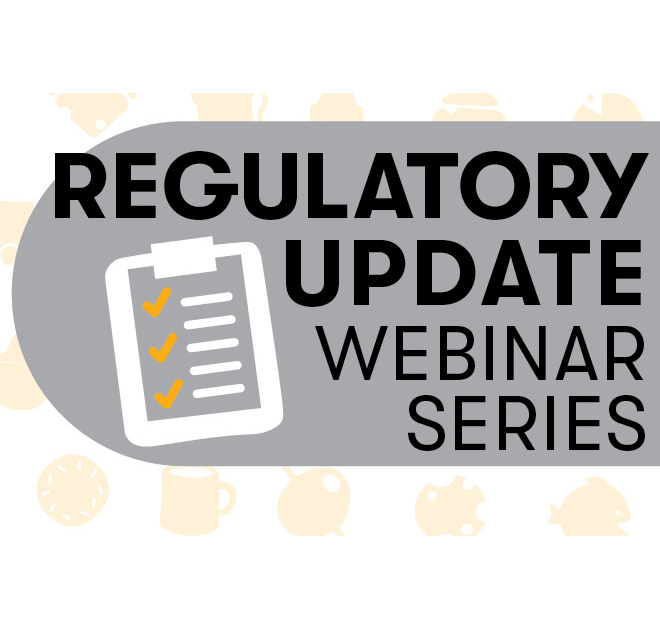Increased incidences of individuals with food sensitives have made getting your food product’s label correct a matter of life or death, warned Jeni Lamb Rogers, associate general counsel, supply chain, for Branded, during last week’s SFA Regulatory Webinar: Advanced Topics in Food Allergen Labeling and Gluten Free.
Why it Matters
According to Rogers, demand for allergen and gluten free foods is increasing. Unfortunately, even very small amounts of an ingredient could cause anaphylactic shock in someone with a food allergy. As a result, allergens are the number one cause of recalls and can lead to litigation.
The Big 8 (Soon to Be 9)
There are eight categorical allergens to be mindful of when labeling your product. The following must be listed exactly as seen below. For example, you may not say “dairy” instead of “milk” or “gluten” in place of “wheat,” she said.
• Milk
• Wheat
• Soy
• Peanut
• Egg
• Sesame (must be listed as of Jan 1, 2023)
In addition, the following allergens must be listed by species. For the full FDA list, visit here.
• Tree Nuts
List as coconut, walnut, almond, macadamia nut, beech nut, gingko nut, pine nut, pistachio, sheanut, cashew, Brazil nut, hazelnut, etc.
• Crustacean Shellfish
List as crab, lobster, or shrimp
• Fish
List as salmon, trout, pike, or halibut
How to Comply
There are two ways to make an allergen declaration, Rogers explained:
In-text approach: older, shorter method, takes up less space, better for traditional products with long ingredient lists
Example: Ingredients: Enriched flour (wheat flour, malted barley, niacin, reduced iron, thiamin mononitrate, riboflavin, folic acid), sugar, soybean oil, high fructose corn syrup, whey (milk), eggs, vanilla, natural and artificial flavoring) salt, leavening (sodium acid pyrophosphate, monocalcium phosphate), lecithin (soy), mono-and diglycerides (emulsifier)
“Contains” approach: additional declaration, more modern and common, needs to be in text as prominent as the ingredient list, common on clean label products, simpler and more transparent aesthetic, risk if you fail to carry down one of the allergens from ingredient list
Ex: Ingredients: Enriched flour (wheat flour, malted barley, niacin, reduced iron, thiamin mononitrate, riboflavin, folic acid), sugar, soybean oil, high fructose corn syrup, whey, eggs, vanilla, natural and artificial flavoring salt, leavening (sodium acid pyrophosphate, monocalcium phosphate), lecithin, mono-and diglycerides (emulsifier) Contains: Wheat, Egg, Milk, Soy
Gluten Free Claims
Gluten includes grains such as wheat (a major allergen), rye, and barley, according to Rogers. Gluten and gluten free diets have emerged from an increase in individuals with celiac disease or gluten intolerances.
Regulation: Must have less than 20 PPM gluten to bear claim
Retail reality: Check with your buyer if they require certification to bear the claim
Litigation reality: Must not have any detectable gluten to bear the claim
Rogers warned that another dynamic to consider is related to contract manufacturing. If a gluten-free product is found to have over 20 PPM of gluten, you must check for wheat as this could be the difference between a Class I and Class II recall.
Shared Facility Declarations
Shared facility declarations are not required but can be included right after the allergen declaration above the name and place of business, stated Rogers. She provided the example below:
This product was processed in a facility/on shared equipment with Tree Nuts and Wheat subject to an appropriate allergen control program.
Why make it? Rogers acknowledged it won’t prevent a recall if the allergen ends up in the product, but it could be used as mitigating evidence in a lawsuit because you attempted to provide a warning. Furthermore, it’s really about deterrence. Rogers said a highly sensitive consumer is less likely to buy your product if it contains a shared facility declaration. She noted you do not need to list each allergen species here.
'Free' and 'Friendly' Claims
If you’re going to make a “free” claim, the ingredient statement is not enough. You should have at a minimum, a dedicated line and a dedicated facility, Rogers said.
In the eyes of the consumer, “friendly” equals “free”. As a result, you are responsible for all interpretations of this claim. If a product is allergen friendly, then the reasonable consumer is likely to conclude that it is “free” of such allergens.
In the event of litigation, brand damage is likely. Be sure to balance the value versus the risk of what happens when you don’t have full control over supply chain.
For a closer look at a product spec and a deeper dive into this topic, watch the webinar recording here.
Disclaimer: This presentation is designed to provide general information on pertinent legal topics, and the statements are made for educational advice. They do not constitute legal advice, and do not represent the views of BRANDED, or any of its attorneys, other than myself. This presentation is not intended to create an attorney-client relationship between you and Jeni Lamb Rogers. If you have specific questions as to the application of the law to your activities, you should seek the advice of your legal counsel.
Related: Sesame to Be Labeled As Allergen; 5 Steps to Enacting a Recall.

